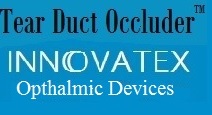 FDA Approved Nasolacrimal Compression Device
FDA Approved Nasolacrimal Compression Device
Eyedrops are like excessive tear that naturally drain through the tear ducts into the throat. Eyedrops medications rely on you to keep the eyedrops in your eyes so that the medications will infuse fully into your eyes to be effective rather than partially drain through the tear ducts into the throat causing possible systemic side effects. The delivery of eyedrops medication will improve when nasolacrimal drainage is blocked. Therefore, a standard care procedure called “nasolactimal occlusion” is recommended by ophthalmologists for patients to use fingers to press on their tear ducts while instlling eyedrops. This procedure is illustrated as Eyedrop Tips posted on Glaucoma Research Foundation website. However, this procedure may be too burdensome to practice, especially for those patients who use too many drops, or simply could not locate their tear ducts, or press on them long enough.
We, therefore, invented Tear Duct Occluder(R) the only FDA approved Nasolacrimal Compression Device to help patients to perform nasolacrimal occlusion while inatillating eyedrops. This device held U.S. Patent 8147467 in 2012 and received FDA De Novo approval in 2016 which resulting in establishment of Federal Regulation 21 CFR 886.5838.
The One-Size Fit-All Device
The fitting of Tear Duct Occluder(R) is not an issue. After one year of clinical trials, a “one size fits all” Tear Duct Occluder was developed. The geometry of the device was clinically established to fit all humans regenardless their races. This device has a stainless steel and is pre-formed in the factory to be “one size fits all.” The only adjustment, if any, would be widening or narrowing the nose pad gap across the nose which can be done by patients.
Human Factors and Usability Engineering (HFE/UE)
Practicing Nasolacrimal Occlusion (NLO) while applying eyedrops has been clinically proven being effective to improve eyedrops efficacy and prevent adverse systemic side effects from eyedrops ([1], [2] Page E-9.) FDA has approved the original Tear Duct Occluder for performing NLO since 2016 and classified it under 21 CFR 886.5838 for Rx only Use because it requires eyecare professionals to fit each device to individual patients and validate the fitness. This HFE/UF study aimed at investigating the actual efforts of eyecare professionals in the use of this device and seeking opportunities to minimized their efforts. Both clinical and in-home use were applied in human factor validation testing. The validation consists of 3 phases: the first phase took 1 year to investigate the use problems of the original Tear Duct Occluder at 3 university medical centers, 1 medical conference and several local eye clinics; the second phase took 9 months to fit the device to 38 patients in an eye clinic and seek design improvements on the Tear Duct Occluder; the third phase took 2 years to collect the user experiences about the new version of Tear Duct Occluder in 23 states, 1 U.S. territory and 20 foreign countries.
The study concluded that using this new Tear Duct Occluder was as safe and effective as the original Tear Duct Occluder but without requiring eyecare professional’s effort to fit it to patents. The evidences that supported this argument are as follow:
- The depression curves along the nasal aspect of the orbital rim were found to be the same for all patients – this finding enabled us to design a unique nose pad shape which fits all patients.
- The device fit all patients – over past 2 years of commercial distribution, patients (of diverse races, genders and ages) either used it “as is” or occasionally made minor adjustment on the nose pad gaps across the nose. The silicone rubber surface of the nose pads adapted to patient’s orbital rim contour seamlessly. No doctors were involved in fitting the device. No unfit issues nor other adverse effects have ever been reported.
- Patients used the device -patients routinely used this device at home without doctor’s supervision. They liked this device because it produced anticipated results had alleviated the burden of using fingers to press nasolacrimal ducts while applying eyedrops.
- Patients maintained the device – When patients advertently messed up the device (while packing for travel), they either fixed it by hands or ordered a replacement. A messed-up device would not perform as well but had not harmed any patients.

